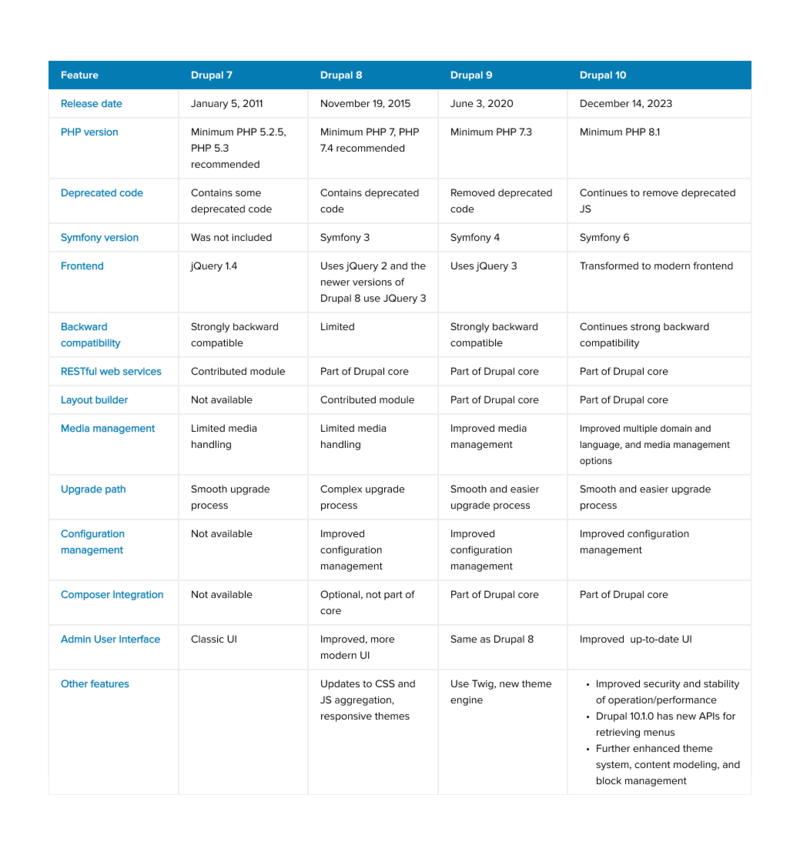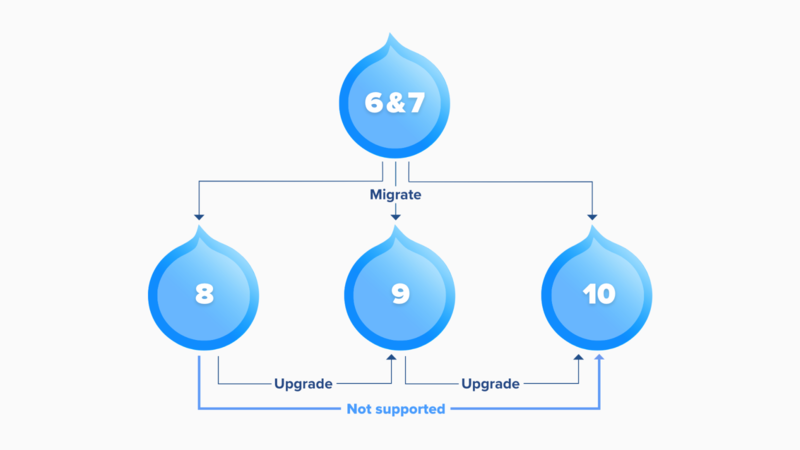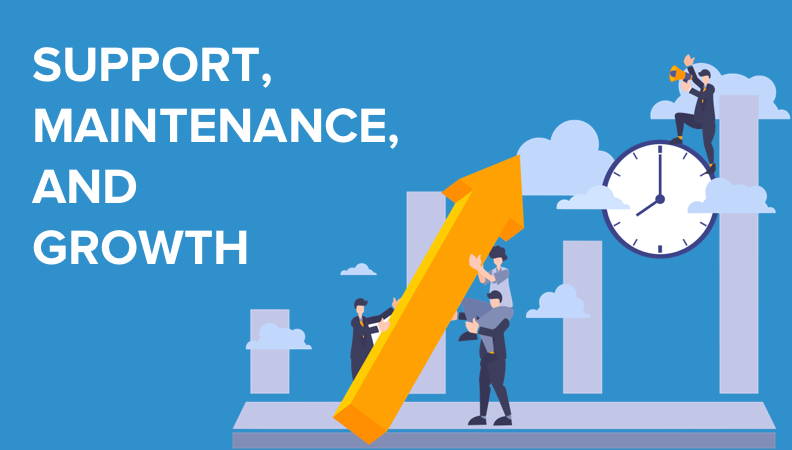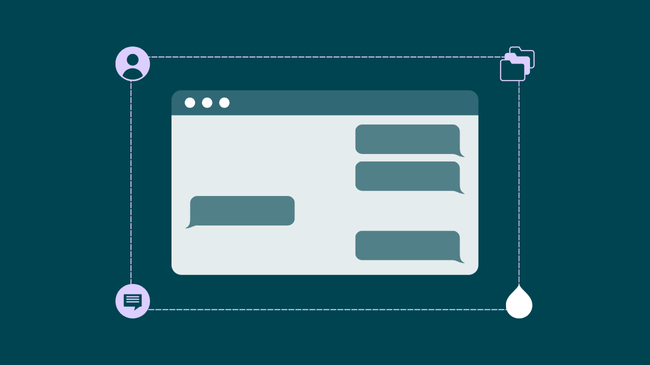- Solutions
- For Industry
- By Need
- Products
- VarbaseEnterprise CMS Distribution for Drupal
- Uber PublisherEnterprise Digital Media Platform Builder
- VardocDrupal Knowledge Base Platform
- Campaign StudioOpen Marketing Platform - by Acquia
- Open SocialSocial Business Platform - by Open Social
- Services
- Strategy
- Design
- Development
- Migration
- Support and MaintenanceSupport and Maintenance
- DevOps
- Digital Marketing

Datasheet

- Clients
- Ideas
- About
- Contact Us

What Is Drupal? Why Does It Power Over 10% Of the Top 10,000 Websites?
Drupal, a free content management system (CMS), is responsible for powering more than 1.7 million websites globally, including 12,8% of the top 10.000 websites. Being highly customizable and scalable, Drupal is well-suited for developing large-scale media portals, government platforms, and enterprise-level complex web applications. In this article, we provide an overview of this system and a comparison of Drupal, WP, Joomla, and Magento CMSs.
What is Drupal?
Drupal is an open-source CMS written in PHP and distributed under the GNU General Public License. Basic installation and administration can be performed without programming skills, but to leverage the full power of Drupal's features, expert Drupal development support would be essential. Drupal's core and its extensive ecosystem of modules are built using the PHP scripting language and Symfony, a popular modern framework. To run a Drupal website, you need a platform supporting a web server with PHP and a database for content storage.
A Content Management System (CMS) is software designed to assist users in creating, managing, and modifying website content without requiring technical expertise.
Drupal simplifies the process of creating and publishing digital content. It boasts a vast collection of modules and themes that can attract web audiences, enhance brand recognition, and foster a sense of community.
It supports unlimited content types and provides straightforward tools for creating, editing, retrieving, and presenting content to end users. It also has a sophisticated user role classification and permissions system, allowing you to control access to its features and content effectively.
The most recent version, offering powerful tools for building structured content and managing websites, is Drupal 10.1, which was introduced in June 2023.
Drupal is an advanced digital experience platform (DXP) with capabilities for content management, personalization, customer journey mapping, and customer data management. Compared to other CMS platforms, it is more straightforward, better structured, and clearer from the developers' perspective.
Comparing Drupal, WordPress, Joomla, and Magento
Drupal is favored for complex, enterprise-level websites, WordPress for user-friendly content management, Joomla for medium-sized sites and community portals, and Magento for e-commerce solutions. Choosing the most suitable CMS depends on your specific requirements, technical expertise, scalability needs, and the type of website or application you intend to build.
Each option has its pros and cons that you should consider in order to make an informed choice between different CMS platforms.
Vulnerability Issues with WordPress
While the WP platform itself is secure, it has constantly faced various vulnerability issues. The vulnerabilities can arise due to factors such as outdated software, poorly coded themes or plugins, weak passwords, and a lack of regular updates.
Steep Learning Curve for Drupal
As a well-structured and powerful system, Drupal demands hands-on practice. Attending meetups, and participating in workshops can provide valuable support and guidance to grow your expertise and utilize the whole power of Drupal.
Functional Limitations for Joomla
These issues can be solved by adding different extensions, some of which are not regularly updated or poorly maintained, and to set them working properly you need high technical expertise.
Complex to Set Up and Maintain for Magento
Magento can be resource-intensive, both in terms of server requirements and development time. It may require powerful hosting infrastructure to ensure optimal performance, which can lead to higher hosting costs, and it can be complex to set up and maintain, requiring dedicated development resources.
What is Drupal Used For?
Drupal finds extensive application across diverse sectors, including entertainment, financial services, government, education, and others. Top enterprises, Fortune 500 companies, nonprofits, and government organizations extensively use Drupal. Among its users are Warner Music Group, Fannie Mae, the Government of Australia, Princeton University, and Pfizer. Drupal, being an open-source software, can be freely downloaded, modified, and shared without limitations.
At Vardot, Drupal is our main specialization, and with over a decade of experience in Drupal development, we have the expertise that has led many of our projects to broader public awareness and international awards.
Drupal Features
The key advantage of Drupal is its well-organized and logical system structure, which leads to a clear, manageable, and scalable system offering the following features:
Flexible Content Architecture
Drupal allows easy creation, organization, and management of various types of content, including articles, blogs, images, videos, and more. It provides a highly flexible content architecture, enabling users to define custom content types and fields to suit their specific needs.
Scalability and Performance
Drupal is designed to handle high-traffic websites and can be scaled to meet the demands of growing projects.
Extensive Module System
The platform has a vast library of contributed modules that can be easily installed to add new functionalities and features to your website. These modules cover a wide range of purposes, such as e-commerce, SEO, social media integration, and more.
Themes and Customization
Users can change the look and feel of their Drupal website using themes. Drupal allows for easy customization to match the branding and design requirements of various projects. This can be achieved by adjusting the background, scripts, and animations, and adding standard or special effects and elements.
Multilingual Support
The latest versions of Drupal come with built-in multilingual capabilities, allowing you to easily transform any website into a multilingual platform. It also offers the flexibility for further customization to cater to the preferences of the local audience in any language.
User Roles and Permission
Drupal provides robust user access control, allowing administrators to assign specific roles and permissions to different user groups, ensuring secure and controlled content management.
Security
Drupal has a strong security track record and an active community that continuously works to update the system and address any vulnerabilities.
Mobile Responsiveness
Drupal websites ensure a seamless user experience across various devices and screen sizes.
SEO Friendliness
The platform provides tools and features to optimize websites for search engines, helping to improve the site's visibility in search results.

How to Prepare Migration to Drupal 10?
Till recently, Drupal 9 was the most popular option used by the majority of enterprises, while Drupal 10 was mostly chosen by companies specifically looking for innovative solutions.
However, now more users are switching to Drupal 10 since, starting November 2023, Drupal 9 will no longer receive community-supported security updates. With each release, upgrading to Drupal 10 from Drupal 9 is becoming easier and effortless.

Preparing for Drupal 10 Upgrade
- Install Drupal 9 now, if you haven't done it already
- Install Drupal Upgrade Status module.
- Check whether your contributed modules require an upgrade by navigating to Administer > Reports > Upgrade Status.
- Determine which deprecated APIs must be fixed in custom code.
- Ensure all deprecated APIs are addressed and compatible with the latest Drupal 9 version.
- Use Drupal Rector to automatically correct numerous errors with your custom code.
- Use the Drupal Project Update Bot to get assistance in resolving any difficulties.
Make sure to replace all the above-mentioned components to ensure smooth functioning in Drupal 10. Get professional support for migration from Vardot. This approach will minimize potential issues and ensure that your website can take advantage of the latest features and performance enhancements offered by Drupal 10.
What is Varbase and how does it work?
Varbase is a Drupal distribution (CMS starter kit) equipped with adaptive functionalities and essential modules designed to expedite your development process and provide standardized configurations.
Distributions are comprehensive packages of Drupal that come pre-configured with specific features and functionalities tailored to meet the requirements of a particular type of website. They simplify the process of setting up complex and specialized sites by bundling together Drupal core, a selection of contributed modules, themes, and predefined configurations into a single download.
Key Varbase features
- Mobile responsiveness
- Accessibility
- Compatibility with different browsers
- Enterprise-level security
- On-page SEO capabilities
- Adaptation to different screens
- Simple integration of media
- Automated testing
Varbase offers multilingual support, powerful search functionality, and a media library for managing content. It offers tools for image cropping, rich media embedding, and building customizable forms with email alerts.
It also provides real-time analytics and efficient content categorization. With various layout options, intuitive content promotion, slideshows, and an easy-to-use page builder, Varbase ensures an enhanced user experience and streamlined content management.
Latest advancements:
- Configuration Update Manager and Resource Description Framework are modified to allow for a smooth upgrade to Drupal 10; many internal modules are changed accordingly to simplify the migration.
Varbase is a product of Vardot, an official contributor to the Drupal open-source solution. As of the date of this publication, the latest official version is 9.0.14, with new releases published every 2-3 weeks. Varbase 10.0.1 is scheduled to be released in September 2023. You can always find the latest updates available here.
Is Drupal a framework or CMS?
While equipped with standard CMS features such as user registration, menu management, RSS feeds, taxonomy (a scheme for object classification), and system administration, Drupal is also recognized as a web application framework.
Is Drupal PHP or Java?
Drupal is primarily written in PHP, a popular server-side scripting language. PHP is used for the core functionality of Drupal, including handling database interactions, rendering web pages, and executing server-side logic. Drupal leverages the power of PHP to provide dynamic and customizable content management capabilities.
While Drupal itself is built with PHP, it can be integrated with other scripts and programming languages, such as JavaScript for front-end interactions, and libraries, frameworks, or modules written in other languages to extend its functionality.
Conclusion
Drupal is a robust and versatile content management system that has established itself as a preferred choice for building complex and feature-rich websites. However, it goes beyond mere functionalities: Drupal is a vibrant ecosystem that provides businesses with scalable solutions in the ever-changing digital world and shapes the future of web development.



